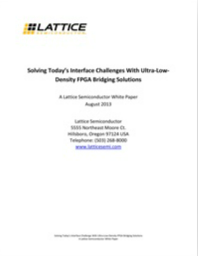Solving Today’s Interface Challenges With Ultra-LowDensity FPGA Bridging Solutions
Designers are implementing a wide variety of interface bridging solutions that allow them to transfer data across protocols and, in the process, expand system functionality. The challenge is determining how to most efficiently implement these new bridging solutions without violating system power, footprint and cost requirements.
This paper looks at potential solutions and examines how designers can tackle the interface challenge by implementing highly optimized bridging solutions in ultra-low density (ULD), low power field programmable gate arrays (FPGAs) that combine the flexibility of a programmable platform with high performance at low power.
Download to learn more.
Read More
By submitting this form you agree to Lattice Semiconductor Corporation contacting you with marketing-related emails or by telephone. You may unsubscribe at any time. Lattice Semiconductor Corporation web sites and communications are subject to their Privacy Notice.
By requesting this resource you agree to our terms of use. All data is protected by our Privacy Notice. If you have any further questions please email dataprotection@techpublishhub.com
Related Categories: Automotive, Communication, Embedded, Image sensors, Industrial, Microcontrollers, Power, Processors

More resources from Lattice Semiconductor Corporation
DESIGNING FOR LOW POWER
Power consumption is becoming an increasingly important variable when it comes to calculating OPEX and carbon footprint for telecom infrastructure ...
THE IMPACT OF ENERGY EFFICIENCY STANDARDS ON STANDBY POWER IN CONSUMER ELECTRONICS DESIGN
As more strict government regulations regarding power consumption appear, even traditional home and office appliances like LCD TVs, set top boxes (...
IMPLEMENTING PCI EXPRESS BRIDGING SOLUTIONS IN AN FPGA
Like its predecessor, the Peripheral Component Interconnect (PCI), PCI Express is becoming a ubiquitous system interface. Unlike PCI, PCI Express a...
